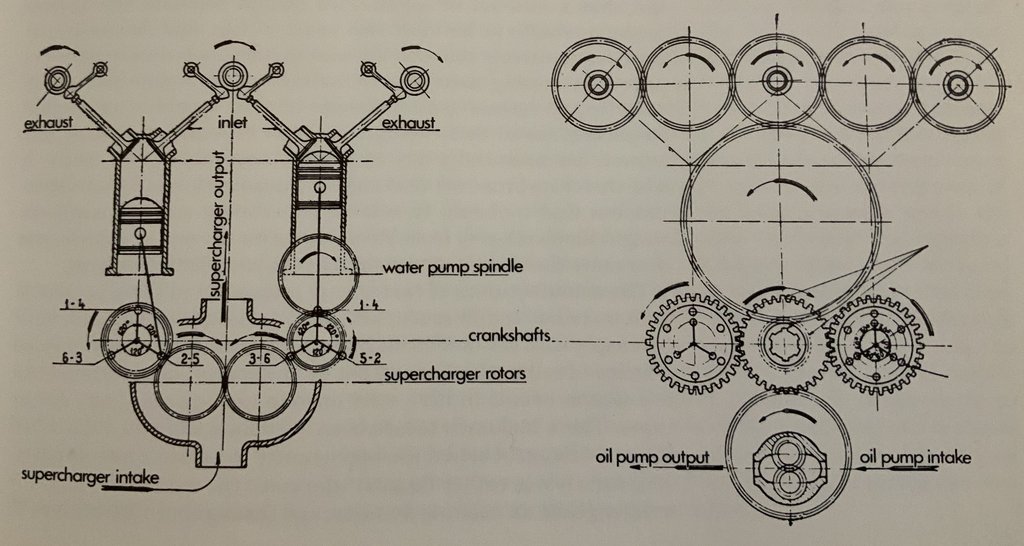This engine needs no introduction, to members of this forum, though there may be some limitations to the information available in the public domain. I myself have only just realised a contradiction which others have probably already resolved.
The January 1951 issue of “Motor Sport” shows a longitudinal cross-section, apparently a factory drawing, in which the crankshaft and main bearing arrangement is clearly apparent. Contrary to what one might expect, there are only four main bearings (not seven as is usually the case with the in-line six): one at each end, one between cranks 2 and 3, and one between cranks 4 and 5.
Moreover, the cranks are disposed quite differently from what is the usual arrangement. Here, crank 1 is aligned to 2, 3 is aligned to 4, and 5 is aligned to 6; while each pair thus formed is at 120 degrees to the next. Compare this with the normal: 1 aligned with 6, 2 aligned with 5, and 3 aligned with 4, again with 120 degrees between each pair and the next.
Now for the contradiction I mentioned. In “The Racing Car” by Clutton, Posthumus and Jenkinson (paperback edition published 1962), it is clearly stated that the firing order is 1-5-3-6-2-4 for each of the two crankshafts; the trouble is that this (the customary sequence for an L6) is only possible with the normal crank arrangement, as described above! The nearest approach to this, with the cranks arranged as in the drawing, is 1-5-3-2-6-4.
Which one is correct? The book is written by acknowledged authorities, but the magazine article is authored by WB, who I imagine is just as dependable!
If that isn’t enough confusion, there is another drawing, also apparently contemporary and possibly a factory drawing, which schematically depicts the auxiliary drives from the two crankshafts, one view for the supercharger drive, the other for the camshaft drive. The crank arrangement shown here enforces yet other firing sequences, the nearest being 1-5-3-4-2-6. (Of course, in all arrangements, many alternative firing orders are also possible, but only within the restrictions imposed by the crank arrangements). This drawing features in “Primotipo’s” blog of 22-11-2019, and is attributed by him to LJK Setright.
So far as good mechanical balance is concerned, and hence freedom from vibration, the customary crank arrangement of an L6 engine, and consequent firing order, is as stated above. The well-known smoothness of innumerable L6 engines, for over a century, stems from this fact.
However, it is not beyond the bounds of possibility that Fiat chose the second arrangement (that shown in the “Motor Sport” article). Well known, at the time, for technical innovation, they may well have sought the several benefits of fewer crankshaft bearings, reduced length and weight being only the most obvious. If that be so, then the second arrangement makes engineering sense, because the “flying” (unsupported) crank web is not subjected to the fearsome combined bending and torsion, that the conventional arrangement would have experienced. The disadvantage, of residual unbalanced inertia moments, is neatly resolved by phasing the second crankshaft such that its moment always cancels that of the first.
It is not easy, however, to account for the third arrangement (that shown by “Primotipo”). As it happens, two-stroke L6 diesels generally use this firing order (the one I mentioned in this context), but of course with the cranks disposed at 60 degrees, not 120, so maybe this is just a coincidence.
Anyone have any information, knowledge or thoughts on this subject? Even if Fiat, at the time, deliberately set out to confuse the issue, so as to misdirect copycats such as Coatalen, by now surely the facts are known.
Firing order may seem to be a mere detail, even trivial, but it is usually the tip of an engineering iceberg, much of it rather subtle.
PS. I’d like to attach the references I’ve quoted, but the procedure is beyond me, so as usual I’m sticking to words, hopefully unambiguous.
PPS. Posted this at first in the Technical Forum, and repeating it here to hopefully get a wider response. Thanks in advance.













